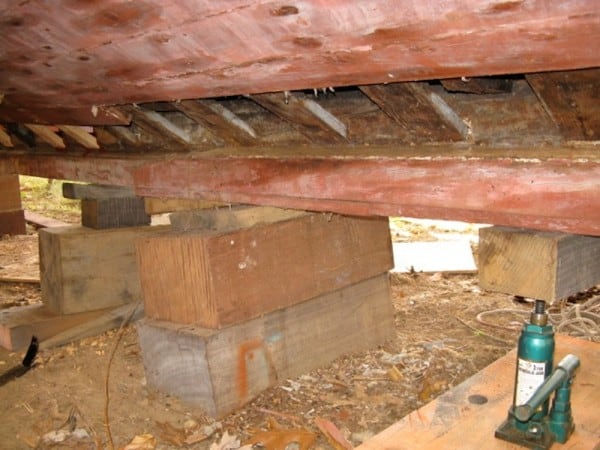I’m back working on the BONNY BRIDE after a summer of CHARLES W. MORGAN sailing and teaching at the Woodenboat School. It’s been a very busy and exciting time. But it’s also a relief to be home and back on the BRIDE project.
The BRIDE’s old 4-71 Detroit diesel went to Cape May to repower a self-righting U.S. Coast Guard lifeboat that a friend of mine is rebuilding for a museum down there.
The engine space on the BRIDE was coated with a heavy layer of oil and grease that the Detroit had leaked and sprayed on it for thirty years, thoroughly coating planking, floors and frames. To clean up this area, I removed the garboards along with the concrete that had been used to fill the voids between the keel and frames. Then I started witha scraper and putty knife and was able to remove most of the grease and oil, although my poor old Shop Vac suffered and still seems to be under the weather. My next step was to buy heavy-duty automotive de-greaser and a variety of sacrificial brushes. To capture the rinse water, I rigged a plastic hammock under the garboards, which was loaded with oil absorbent pads. The de-greaser (purple stuff) worked great. Brushes, however, were fairly ineffective, but very coarse Scotch-brite pads seemed work. I wore rubber gloves, oilskin pants and safety glasses. Two passes of scrubbing and rinsing got me down to the red lead primer. The water that had drained into the plastic hammock was the color of hot cocoa. I let this settle for a week, then decanted off the layer of liquid, and threw away the sediment with the plastic.
. . . sign up to the right to get immediate access to this full post,
plus you'll get 10 of our best videos for free.
Get Free Videos& Learn More Join Now!!for Full Access Members Sign In



Peter Drake says:
Walt,
Thanks for your interesting posts that describe the restoration of the fortunate Bonnie Bride.
Cheers and Happy New Year back at you!
Michael S. Ellegood says:
Great progress report, Walt. One question, “Why did you go with galvanized fastenings?” my experience with them, albeit limited, suggests that they turn into a rusty mess in a few years of being immersed in salt water – and all that work must be done over.
Walt Ansel says:
Hello Michael,
Thanks for the interest! Lets see…. You are absolutely right, galvanized iron/steel fasteners are not a great idea. You get about 25 years of safe use (in a medium sized boat) and then they are done. The acid in oak timbers really cooks them!
Bonny B was built of inexpensive materials and was expected to have a short life compared to a yacht. She is now 44 years old. The galvanized clinch nails are mostly gone. Bonny was refastened with stainless screws about 15 years ago. These fasteners are are now doing the lion’s share of holding planks to frames.
Frankly I couldn’t afford bronze bolts, I operate on a shoestring budget. But also in the big picture, I feel I’m not ruining the boat. My hope is to use her for 10 years and then pass her on to the next generation (who could get five more years of use). It is very doubtful that I will be able to recover my investment in her, even if it is a “shoestring”. Don’t get me wrong, Bonny B has a beautiful shape and should be saved, but her original materials were not first rate.
Cheers Walt
chip puhl says:
Thanks Walt,
A great look into the belly of your project. Every day the rewards of solving another problem. Removing a rusted bolt, making a jig to shape or fit a new rib or plank and you know why you never throw out a pine or oak cut-off or even a broken saw blade.
Looking foreword to your progress